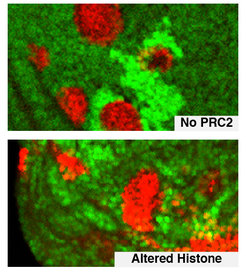Histone Modification Controls Development - Max Planck Researchers demonstrate that chemical tags on histones regulate gene activity
Every gene in the nucleus of an animal or plant cell is packaged into a beads-on-a-string like structure called nucleosomes: the DNA of the gene forms the string and a complex of proteins called histones forms the beads around which the DNA is wrapped. Scientists of the Max Planck Institute of Biochemistry in Martinsried near Munich, Germany, have now established that adding chemical tags on histones is critical for regulating gene activity during animal development. Studies over the past two decades revealed that many proteins that control the activity of genes are enzymes that add small chemical tags on histone proteins but also on a variety of other proteins. With their studies the researchers have now shown that it is the tags on the histones that control if genes are active or inactive. Their results were published in the journal Science.

Histone proteins can be modified by a number of different chemical tags at very specific sites. The researchers in the Research Group ‘Chromatin Biology’ of Jürg Müller focused on the histone tag that is added by an enzyme called Polycomb Repressive Complex 2 (PRC2). PRC2 is essential for a variety of different cell fate decisions in animals and plants. PRC2 functions to keep genes inactive in cells and at times where they should remain inactive.
Using the model organism Drosophila - the fruit fly - the scientists now generated animals with cells expressing an altered histone protein to which PRC2 can no longer add the tag. These cells cannot keep genes inactive anymore and many cell fate decisions go awry, exactly like in cells that lack the PRC2 enzyme. “This observation demonstrates that the business end is the tag on the histone and not on some other protein” says Ana Pengelly, the PhD student who conducted the experiments. Her colleague Omer Copur adds: “The approach we used permits us to now also investigate the function of other tags on histone proteins that have a different chemical nature.” The insight gained from the work on PRC2 provides a strong impetus to figure how this tag alters the beads-on-a-string structure of genes and thereby controls gene activity.
Original Publication
Pengelly, A.R., Copur, O., Jäckle, H., Herzig, A. and Müller, J.: A histone mutant reproduces the phenotype caused by loss of histone modifying factor Polycomb. Science, February 8, 2013.
DOI: 10.1126/science.1231382






